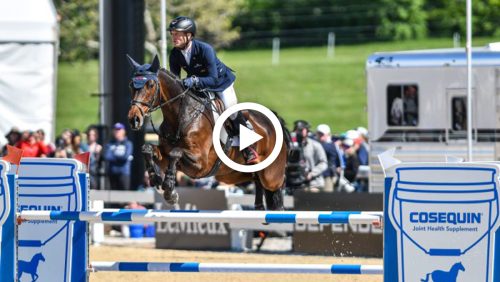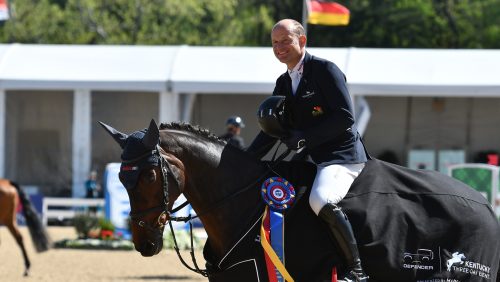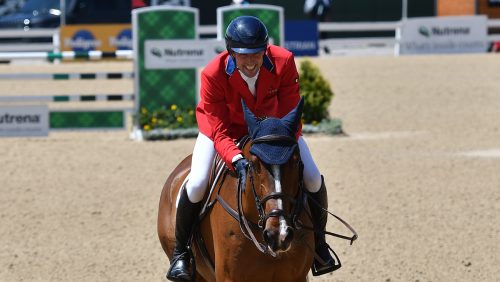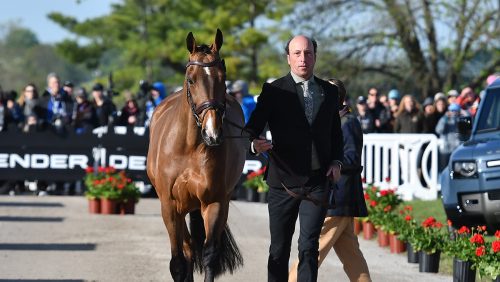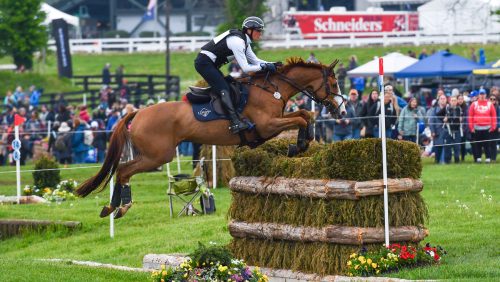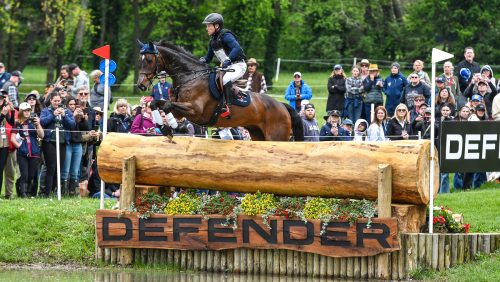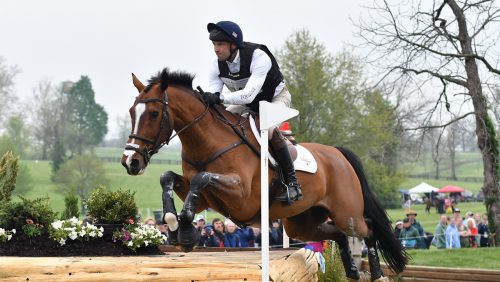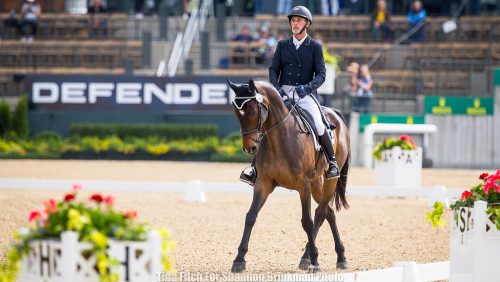“There is no such thing as a bad distance on a bending line. You can make any distance work for you.”
Those were the words of wisdom from two-time Olympic individual gold medalist Mark Todd to participants at his Jan. 26-27 clinic in Fresno, Calif. The eventing legend faced five groups of riders from the novice level to the intermediate level, and Day 1 was conducted in the show jumping ring.
Todd started each group with the same exercise: three jumps set on an arc, vertical-oxer-vertical. Walked center to center, it was a perfect five-stride to five-stride, but to start with Todd wanted everyone to get six strides. As the warm-up progressed, he then wanted them to get five in one direction and six in another, and then five and five both ways.
 |
| Gina Miles practicing the turning exercise. |
He emphasized the importance of knowing your horse and their canter, so you can know whether you need to cut in or drift out on the bending line to get the desired striding and distance. He also said he makes the middle fence an oxer, as the spread encourages the horses to drift more, thus making the rider have to really keep the horse on their line, contained between the seat and leg.
“We can teach a horse to stay straight on a straight line,” he said, “but we also have to teach them to stay on their straight line on a bending line.”
One group featured three big-striding horses and two large ponies with much shorter strides. Although some dispensation was made for the ponies’ stride, Todd emphasized to the riders of the ponies that they should be able to change their line in the bending lines to still get the correct striding, despite their horses’ shorter natural stride. He made the same point to the big striding horses’ riders when the exercise required a shorter stride.
The next exercise featured a small one-stride combination, with then a curving S-shaped line to an oxer. In the middle of the S Todd placed a pole. Riders were instructed to get four strides to the pole on a right handed curve, step over the pole, changing their bend and encouraging a lead change, then getting three strides on a left-handed bend to the oxer. Again, the emphasis was on creating the necessary canter early, and then carving the line you needed for your horse to make the distance work.
While most of the show jumping exercises focused on getting specific striding, Todd was clear it was in the context of knowing your horse, its stride and canter, and being able to make decisions while walking or riding a course based on what you know of your horse. He emphasized repeating these types of exercises until you know your horse inside and out.
Each group finished with a course of the various related-distance exercises, some requiring a shorter stride, and some requiring a longer one. Most featured bending lines, but some straight ones also. Todd wanted to see riders making good decisions as to how to get their horses around the course, getting all the prescribed number of strides.
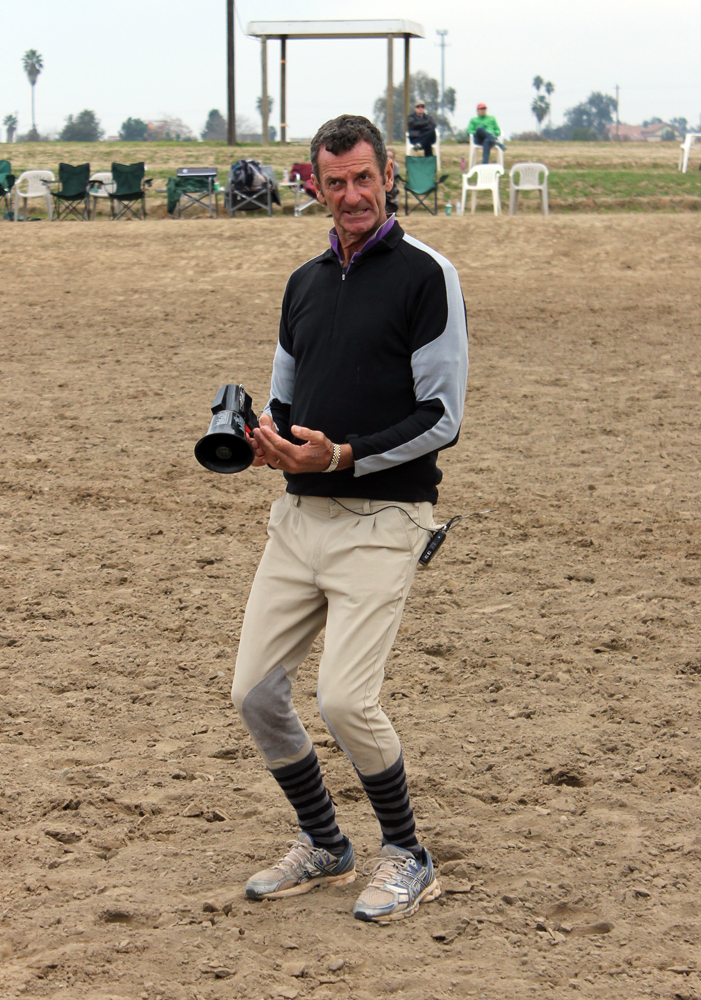 |
|
Mark Todd demonstrated the |
On cross-country day (Day 2), Todd had all the groups warm up as in an actual cross-country warm up—everyone cantering and jumping in a group, without specific instruction. He suggested that when you warm up for cross-country, you jump from different kinds of canters, to encourage different distances. He also suggested jumping on angles and doing some gallop fences and some waiting fences.
Once they started schooling, his emphasis was on putting several fences together, not just jumping one fence. All levels started early with a rather challenging turning question, a canter up a slight hill to jump a shark’s tooth, landing on a significant down slope and having to immediately take a hard right to jump a small house at the bottom of the down slope on a 90 degree turn from the shark’s tooth.
Again, the emphasis was on having a stride and jump at the first fence that would set you up best for making the turn for the fence at the bottom. The more careful or looky horses could be ridden a bit more forwardly, while the bold horses needed to be ridden more quietly. He emphasized trying to get a deep distance at the first fence of technical questions, to give you the best chance.
ADVERTISEMENT
In between jumps, he wanted the riders to send their horses forward, so they then had “options” in creating whatever canter was necessary for the next question. At Training level and above riders were asked jump a shark’s tooth, canter six or seven strides to a log on a mound, then canter four or five strides down the mound to a skinny.
The jumps were on a semi-circle also, echoing the exercise from the show jumping work the day before. While Todd didn’t care what striding the riders got, each time they jumped it he wanted them to tell him ahead of time which striding they were going to ride.
Todd got on two horses in the clinic. The first was David Koss’ intermediate mount, Clarissa Purisima, on show jumping day. The horse was resistant to half-halts, and Koss kept lifting his hands to give him greater impact. Todd got on to demonstrate half-halting with a lower hand.
On cross-country day, he got on a novice horse who had a tendency to get strong. The rider’s attempts to contain him got him bouncing up and down in to a shorter and shorter stride, eventually stopping at the jumps. Todd proceeded to gallop the horse more and more forward, until the horse was comfortably keeping a consistent stride to all the jumps.
When he hopped off to hand the horse back to his beaming owner, he smiled and said, “I made it look easy, but, you know, it’s sort of my job.”
Tips and Tidbits:
– When schooling jumps, always have control before and after the exercise. Don’t just land and start patting them and let them finish how ever they want. Land and school them a bit and do good transitions. If they’re a little hot, then bend them and work them. If they’re a little dull, gallop off and then put them together.
– “Always be think about how to get to the fence in the best possible way. Don’t just be thinking, ‘*$&^# there’s a jump, I’ve got to get over it.’”
– Turn with both reins rather than just the inside rein, to help prevent the outside shoulder popping out and losing your line.
– The more you look where you are going, the more likely your horse is to land on the correct lead.
– If you have a bad jump or mistake, “No matter what happens you have to put it behind you and keep going and ride the next thing.”
– Todd said that a study was done in England as to why riders in the show jumping discipline consistently get good distances at their fences more than other riders, and the study showed they look at their jumps significantly earlier than any other riders. So if you want to get better at seeing a distance, look at your jumps as early as possible.
– The speed you start an exercise at should be the speed at which you finish it.
ADVERTISEMENT
– In order to use your reins correctly and effectively, you must be able to sink down in your heels and maintain your own balance.
– “You don’t want your eye and brain affecting what you’re doing. The worst thing your brain can do is tell you ‘I’ve got to do something,’ but you’ve got to override it.”
– On training cross-country: “I don’t like training cross-country, I’m never quite as brave, and neither are my horses. But you can effectively school the more technical questions.”
– “You don’t have to take the first distance you see—there is always another one.”
– “When you want to go forward, you must allow with the reins as well. Don’t drop the reins, but you can’t just put your leg on, but sit stuck and still hang on their face.”
– “Cross-country is always full of surprises. Sometimes things go wrong and you have to go to autopilot, but it’s always good to start with a plan [of how you are going to ride something].”
– “When you’re sitting on your bum, your leg is much more effective.”
– “If you find yourself in [the position of having too short a step and too short reins [in front of a jump] you have to just keep holding and kick and press more. You can’t hold-hold-hold-and, then drop.”
– At a jump on the edge of the water, always try to get to the base, so that the horse isn’t already in the air when it sees the water. For jumps in the water, treat them like a normal fence and ride the best canter you can.
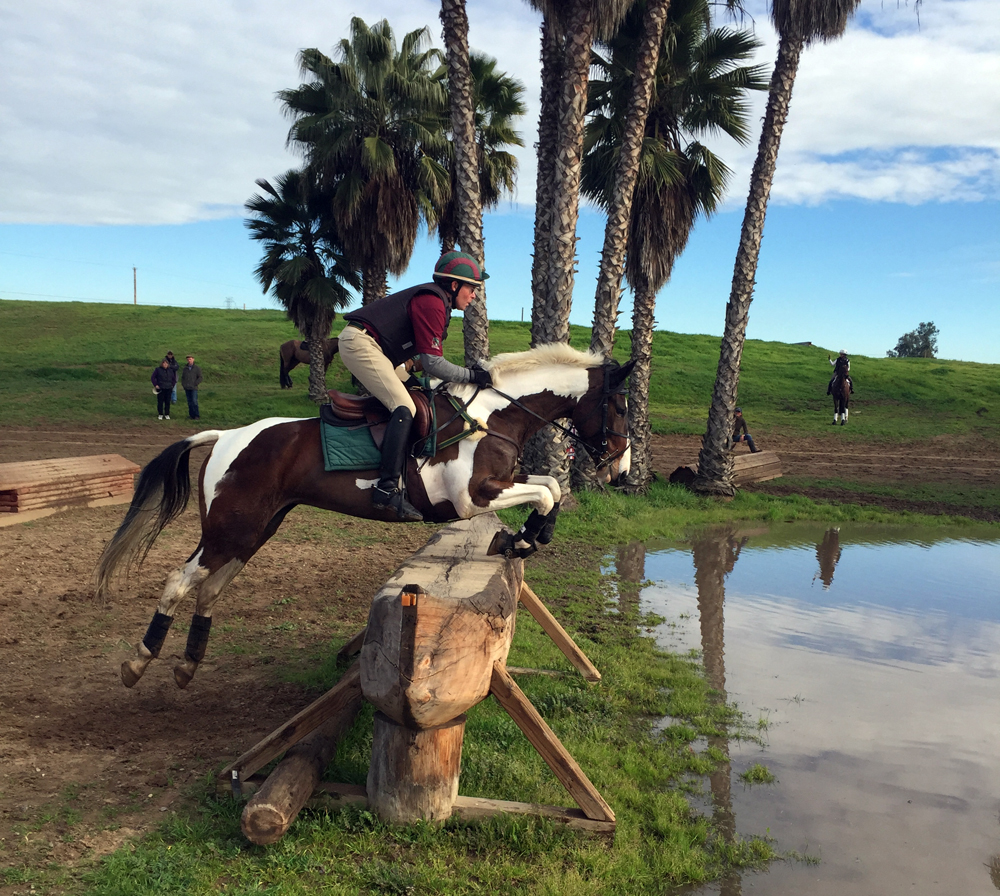
Todd wanted the riders to get a deep distance to this fence on the edge of the water,
so that the horse sees the water landing before they are in the air.

Mark Todd (right) swung a leg over his retired advanced partner Aberjack to teach cross-country.







